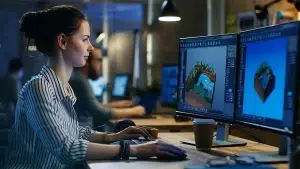If you’re considering prototyping or building something imaginative, 3D printing can quickly help you realize your vision. You must have the required skill in 3D file design if you want to make the utmost use of fast prototyping to its maximum.
Computer-Aided Design (CAD) software can be used to create these files. Modeling and product design already make extensive use of these applications. There are certain things that must be considered while making modelling for 3D printing, even though the basics of 3D modelling are the same across all design verticals.
Modeling for 3D printing differs slightly from 3D modeling for renders. Layers 3D printing experts have created important design criteria to assist you in producing flawless and accurate prototypes and models using 3D printing.
Keep in mind the minimum wall thickness
The minimal thickness that your model must have at any given point is known as the minimum wall thickness. The printing process and material selected affect the minimum printable wall thickness. Make sure to read the design manuals for the material of your choice.
Keep in mind that sometimes problems can also occur due to maximum wall thickness. Know how to give each surface of your 3D model proper wall thickness. This step may have a different version depending on the 3D modelling software. However, it is vital for preparing a 3D print.
Imagine, evaluate and think about your design. If it has any weaker sections, make sure to add the design elements that will support them.
Study printing material guidelines
Each printing material has a unique composition. Materials can be fragile or robust, elastic or rigid, smooth or textured, heavy or light, and so forth. An item should be designed as per the specific type of material. For instance, if you intend to print your 3D model in ceramic, there are special design considerations that must be made, such as supporting overhanging areas, strengthening protruding pieces, rounding off corners, and so on. Being one of the top 3D printing companies in the UAE, we are here to guide you on this.
Choosing your printing material are one of the fundamental designing principles that you must follow. Some materials can be used to construct thin walls because they are strong and durable. Some strong and thick materials such as ABS can be used to make walls to minimize cracking and fracture after 3D printing. Therefore, the designer must structure the models as per the properties of the material to be printed. It will also help if the person is technically competent and can guide the designer with the actual drawing process.
Design to avoid or reduce supports
Despite constant upgrades in support algorithms, base material or support material can still leave unsightly blemishes on the surface of your prints. It will also take a good amount of time to remove the support material. Hence, it is best to create your models so that they can be 3D printed without assistance to prevent such issues.
Keep in mind the 45-degree rule that overhangs that are more than 45 degrees require support. You can use creative modelling techniques to print the model. Design your own support/bridging items into your models, such as cones and other base elements. Mix the supports into your core design at all times.
Model must be watertight
It is necessary for the model to be entirely closed, typically known as “watertight.” You can do this by including a 3D mesh suitable for 3D printing. Most 3D design software programs readily offer the option to produce mesh. Make sure to do this procedure before the model is exported as an STL file as it may be challenging to identify and correct issues after the model has been transformed. This issue can also arise while transferring files between modelling systems.
Study the STL File resolution
The most common file format for 3D printing is Standard Triangle Language (STL). Simply said, your design will be translated into triangles in the 3D space. The majority of 3D modelling software applications will give you the option to export your creations to an STL file while helping you set the required resolution.
When modelling for 3D printing, resolutions that are too low or high can lead to issues
Low-resolution STL file: It’s crucial to understand that a bad export will never be able to produce a high-quality print. Having low resolution results in large triangles in your STL file and an uneven print surface. A lower-quality print will look “pixelated,” similar to digital imaging.
Very high-resolution STL File: A file with a high resolution will make your file too big and provide difficulties while printing. Printing will take longer than usual because of the increased level of detail, and some 3D printers might not be able to print it at all. Before exporting your model to our website, we advise you to keep the file size to no more than 15 MB. Please get in touch with us if you have any questions or need more information on the resolution of your model.
Build a solid foundation
Typically, the model is created one layer at a time with the help of desktop 3D printers. A surface known as the bed is used to melt and extrude the plastic filament (PLA or ABS) used in 3D printing. This first layer must stick to the bed during the print process. Most of the time, the very first layer of printing fails due to a lack of grip. Make sure your model has a solid base by making sure it is designed that way. This will guarantee the strength, durability, and robustness of your 3D-printed models. Keep in mind the following qualities in the base:
- Make sure there is sufficient surface area to ensure effective adherence to the printer bed. This can also be helped by including a raft in your printing program.
- Make sure your foundation is wide enough to support the model and prevent it from toppling over while being printed.
- Make sure that the model’s base is sturdy enough to withstand warping brought on by various cooling rates.
Strengthen vulnerable areas
If the point of contact or joint is too thin, extended appendages from your model’s core could break off during or after printing. The extra thickness is required where the main body connects to thinner portions, such as the tail, ears, and legs.
For instance, if you are printing a character, consider particular attention to the wrists, shoulders, neck, and ankles. Some materials used in the production process are extremely fragile when printed and can shatter into pieces during handling or cleaning. Some people use an air blaster to eliminate any support material.
You should think about how well your model will hold up to 3D printing. For instance, you might need to change the way your character is posed to bring limbs back to the core and put supporting wires over open wires. This is to increase the robustness of your model.
Wrapping Up
Each 3D printing technology has a unique set of capabilities as well as its own set of design freedoms and constraints. It’s always a good idea to go through the most crucial elements that can make or break a design, regardless of whether you are a seasoned engineer with experience designing for 3D printing or you are new to the area.
On a digital canvas, anything can be drawn in 3D, but not everything can be printed in 3D. You may create digital designs that effectively print if you are aware of the essential elements that go into making 3D models. Being one amongst the top 3D printing companies in the UAE, we are there to provide you with any type of 3D design including architecture scale models, laser engraving, etc.





 Contact us
Contact us
1 Comment
QPwsjAXzuMVRaeS
ebcFDlWyfVonEmC